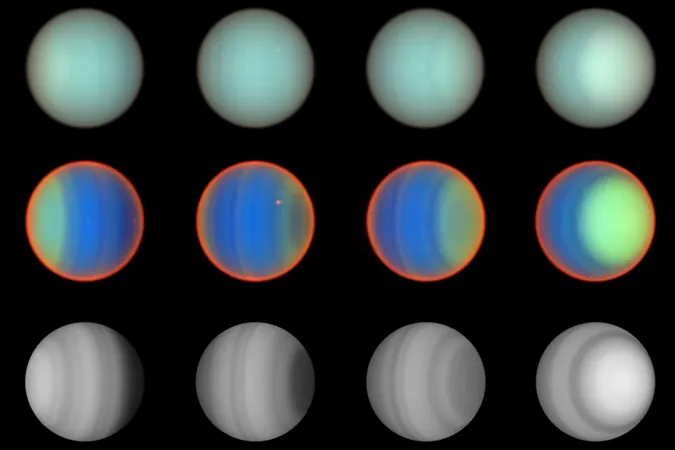
Breakthrough Findings: Hubble Telescope Reveals Mysteries of Uranus’ Atmosphere After 20 Years of Observation!
2025-04-02
Author: Daniel
Unveiling the Unusual: What Makes Uranus Unique?
Uranus stands out as one of the most peculiar planets in our Solar System. Not only is it uniquely tilted on its axis, making it appear to roll along its orbital path, but it also holds the title for the coldest planet, with temperatures reaching a chilling -224 degrees Celsius. Despite being farther from the Sun, its icy neighbor Neptune is warmer, raising further questions about the atmospheric dynamics of these distant worlds. Our first intimate look at Uranus came from the Voyager 2 spacecraft in 1986. However, the Hubble Space Telescope's advanced capabilities have allowed astronomers to monitor seasonal changes over the years, providing a richer tapestry of data since 2002. Uranus orbits the Sun every 84 Earth years, meaning that Hubble has primarily observed the planet during its northern spring, which will culminate in summer by 2030. This unique position changes how sunlight penetrates its atmosphere, affecting its chemical composition.
Hubble's Revelations: The Secrets of Methane at Uranus
Uranus’ atmosphere comprises primarily hydrogen and helium, punctuated by trace amounts of methane, water, and ammonia. Methane is responsible for the planet's striking cyan hue, absorbing red light and posing important implications for the study of similar exoplanets. Between 2002 and 2022, Hubble conducted four significant observations of Uranus, expanding our knowledge of complex atmospheric dynamics. Surprisingly, researchers discovered that methane distribution isn’t uniform; instead, it is notably depleted near the polar regions. This depletion was consistent, remaining stable for the two decades of observations. The atmospheric phenomenon also revealed dramatic changes in the last two years, with the northern polar area brightening as it gears up for summer solstice in 2030. In contrast, the southern polar region exhibited a darker trend as winter approached, showcasing the planet's seasonal atmospheric fluctuations. In an exciting twist, the team, led by Erich Karkoschka from the University of Arizona alongside researchers from the University of Wisconsin, noted variations in aerosol and haze structures as well. The research team aims to shed light on how sunlight influences the atmospheric makeup of these icy worlds.
Implications Beyond Our Solar System
These findings not only paint a clearer picture of Uranus, but they also have critical implications for the study of exoplanets that share similar characteristics. The ability to understand atmospheric circulation patterns and chemical composition dynamics provides a framework for studying distant worlds orbiting other stars, opening up new avenues for astrophysics and planetary science.
Hubble’s Ongoing Mission
As Hubble continues its observations, it remains focused on Uranus, poised to capture more insights as the planet inches toward summer in its northern hemisphere. The quest for knowledge about our Solar System—and beyond—continues, promising even more revelations about the enigmatic blue planet and its place in the cosmic expanse. Stay tuned for more extraordinary discoveries as the Hubble Space Telescope peeks into the ice giant’s mysteries!


 Brasil (PT)
Brasil (PT)
 Canada (EN)
Canada (EN)
 Chile (ES)
Chile (ES)
 Česko (CS)
Česko (CS)
 대한민국 (KO)
대한민국 (KO)
 España (ES)
España (ES)
 France (FR)
France (FR)
 Hong Kong (EN)
Hong Kong (EN)
 Italia (IT)
Italia (IT)
 日本 (JA)
日本 (JA)
 Magyarország (HU)
Magyarország (HU)
 Norge (NO)
Norge (NO)
 Polska (PL)
Polska (PL)
 Schweiz (DE)
Schweiz (DE)
 Singapore (EN)
Singapore (EN)
 Sverige (SV)
Sverige (SV)
 Suomi (FI)
Suomi (FI)
 Türkiye (TR)
Türkiye (TR)
 الإمارات العربية المتحدة (AR)
الإمارات العربية المتحدة (AR)